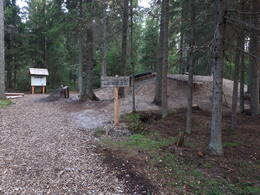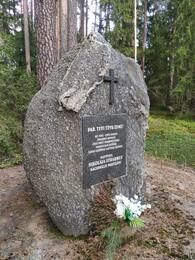Peterio Cheeverso grupės veikla ir sunaikinimo istorija

P. Čeversas aplink save subūrė buvusius legiono karininkus, taip pat priėmė į grupę Kuržemės gyventojus. Visi jie pasirinko likti ištikimi laisvos ir nepriklausomos Latvijos valstybės idėjai, o ne pasiduoti okupacinei užsienio valdžiai. Čeverso grupė dislokavosi Talsų rajono Vandzenės - Upesgryvos - Oktės valsčių teritorijoje, stengdamasi išvengti frontalinių susidūrimų su Čekos kariais ar naikintojų batalionų kovotojais.
Nacionalinis partizanų judėjimas Kuržemėje išsivystė iškart po Antrojo pasaulinio karo pabaigos Europoje 1945 m. gegužės 8 d., kai daugybė žmonių, negalėjusių susitaikyti su antrąja sovietų okupacija arba kuriems grėsė represijos, ieškojo prieglobsčio miškuose. Tarp jų buvo daug buvusių legionierių, tarp jų – 19-osios Latvijos SS divizijos 43-ojo grenadierių pulko 13-osios sunkiosios (prieštankinės) kuopos vadas ir studentų korporacijos „Fraternitas Metropolitana“ filistinas kapitonas Pēteris Čeversas.
Po nacistinės Vokietijos kapituliacijos Kurše, Pēteris Čeversas („Pēteris“) iki 1945 m. gruodžio veikė Otto Akmeņkalėjaus partizanų grupėje, o iki 1948 m. gegužės – kapitono Nikolajaus Straumės grupėje. Vėliau, vadovaudamas maždaug 20 vyrų nacionaliniam partizanų būriui, P. Čeversas aplink save subūrė buvusius legiono karininkus – vyresnįjį leitenantą Jāni Guru („Janka“), leitenantą Alfredą Lauką („Vecais“), leitenantą Augustą Dundursą („Augusts“), taip pat priėmė į grupę vietos Kuršo gyventojus. Čeverso grupė buvo dislokuota Talsų rajono Vandzenės – Upesgryvos – Oktės valsčių teritorijoje, stengiantis išvengti frontalinių susidūrimų su Čekos kariais ar naikintojų batalionų kovotojais. Nors „Miško broliai“ turėjo platų rėmėjų ratą, jie taip pat naudojo vietinių kolaborantų namų plėšimo ir reidų taktiką, taip bausdami juos už bendradarbiavimą su sovietų okupacine valdžia. Čeverui taip pat pavyko užmegzti ryšius su Latvijos SSR Valstybės saugumo ministerijos (VDM) Talsų skyriaus darbuotoju Borisu Moisejevu ir gauti iš jo informacijos apie galimas sovietų saugumo institucijų atsakomąsias priemones.
Čekai pavyko atskleisti paskutinį grupės bunkerį 1950 m. vasario 3 d., Čeversui nepavykus atsisakyti patikimo partizanų rėmėjo Vilio Ģērmanio prašymo kartu atšvęsti 1949/1950 m. sandūrą.
Tai pažeidė nerašytą „Miško brolių“ taisyklę – neatskleisti informacijos apie partizanų bunkerio vietą niekam už grupės narių ribų ir nevesti nieko į bunkerį.
Čekistai apgavo Đērmanį, kad šis jį suimtų ir tris dienas laikytų areštinėje, muštų ir kankintų, grasintų nužudyti jo žmoną ir dukterį, kol jis sutiks parodyti joms, kur yra bunkeris. Atvykęs į Vandzenės miškus, Đērmanis iš pradžių nuvedė čekistus klaidingu keliu, suteikdamas miško broliams galimybę pabėgti. Tačiau išgirdę miške triukšmą, partizanai į jį nekreipė deramo dėmesio, manydami, kad triukšmadariai yra vietiniai Vandzenės medžiotojai. Kai čekistai suprato, kad yra apgaudinėjami, jie vėl sumušė Đērmanį, ir šį kartą jis buvo priverstas eiti teisinga kryptimi. Vienas iš miško brolių, budėjęs sargyboje, prarado savitvardą ir atidengė ugnį. Pagal Latvijos SSR VDM 2-N dalinio 2-ojo diviziono viršininko majoro Krūminio pasirašytą aktą dėl specialiosios operacijos prieš Čeveros grupę, 1950 m. vasario 3 d. mūšyje su daugiau nei 300 karių Čekos pajėgomis žuvo šeši miško broliai – Vilis Liepa, Jānis Lapiņš, Ilgvaras Lapiņš, Jānis Prauliņš, Valija Biša ir Ilga Siliņa (abi moterys, mirtinai sužeistos, paprašė savo bendražygių jas sušaudyti, kad nereikėtų kentėti). Likę, išsiveržę iš dvigubo apsupimo, pabėgo nuo persekiotojų. Mažiausiai trys žuvo nuo partizanų ugnies, o vienas Čekos kareivis buvo sužeistas.
Kapitonas Čeveris ir dar septyni partizanai buvo sugauti 1950 m. lapkričio 1 d. Engurės miškų masyve, kur, visiškai atsitiktinai, netoliese buvo dislokuota netikra partizanų grupė, vadovaujama buvusio Legiono leitenanto Arvydo Gailīčio (agento-kovotojo pravardė „Grosbergas“). Joje buvo Latvijos SSR VDM operatyvininkų ir agentų-kovotojų, apsimetusių „miško broliais“.
Vandzenės partizanai ir jų rėmėjai. Blumų šeimos tragedija ir „Valdų“ namų paslaptis / Straipsnis (lsm.lv)
Uldis Neiburgs (istorijos daktaras, Latvijos universiteto Latvijos istorijos instituto mokslo darbuotojas)
Susijusi laiko juosta
Susijusios temos
Susijusios vietos
Petro Čeverso nacionalinių partizanų bunkeris
Petro Čevero nacionalinių partizanų bunkeris yra Laucienės savivaldybėje, apie 4 km nuo Talsų–Upesgryvos kelio. Į jį veda medžio drožlėmis grįstas takas. Atnaujintas 31 kvadratinio metro ploto bunkeris pastatytas iš betoninio karkaso, apdailintas pusrąsčiais, kad būtų sukurtas autentiškas vaizdas.
Kapitono Čeverio grupė bunkerį miške netoli Vangzenės baigė statyti 1949 m. spalio pabaigoje. Buvo planuojama išgyventi 1949–1950 m. žiemą. 1950 m. vasario 3 d. vietos miškininkas išdavė partizanus, ir bunkerį užpuolė daugiau nei 300 kareivių Čekos dalinys. Tuo metu bunkeryje buvo 19 žmonių – 17 vyrų ir dvi moterys. Šioje nelygioje kovoje žuvo šeši partizanai, tačiau kitiems pavyko pralaužti dvi Čekos apsiausties grandines, kovojant. Žiemos pabaigoje partizanai su savo rėmėjais slėpėsi aplinkiniuose namuose, tačiau pavasarį grupė vėl susivienijo, kol 1950 m. lapkritį buvo užimtas ir sunaikintas. Po Čekos kariuomenės puolimo bunkeris buvo susprogdintas, ir prieš jį atstatant liko tik vandens pripildyta duobė.
Nikolajaus Straumės nacionalinio partizano atminimo akmuo
Atminimo akmuo yra Slokos–Talsų plente, netoli Ridelių malūno.
Kapitono Nikolajaus Straumės („Buks“) nacionalinis partizanų būrelis buvo suformuotas netrukus po vokiečių armijos kapituliacijos ir veikė Tukumo ir Talsų rajonų miškuose. Būrio branduolį sudarė Latvijos legiono karininkai ir kareiviai, prie kurių prisijungė ir vietos gyventojai. Žinomos 38 narių pavardės. 1945 m. gruodį grupė Laucienos valsčiuje įrengė žiemos bunkerį 10–12 kovotojų. 1946 m. sausį Sovietų Sąjungos valstybės saugumo liaudies komisariato kariuomenė bandė apsupti stovyklą, tačiau visa grupė sėkmingai ištrūko iš apsupties be nuostolių. Nuo 1947 m. kovo iki 1948 m. spalio sovietų kariuomenė įvykdė keletą operacijų, suimdama nacionalinių partizanų rėmėjus ir nužudydama kovotojus keliuose mūšiuose. Nikolajus Straumė buvo sušaudytas 1948 m. spalio 13 d.
Nikolajus Straume buvo vienas iš Talsų ir Tukumo nacionalinių partizanų grupių bendros veiklos vadovų.






